ANCIENT EGYPT—PART 2
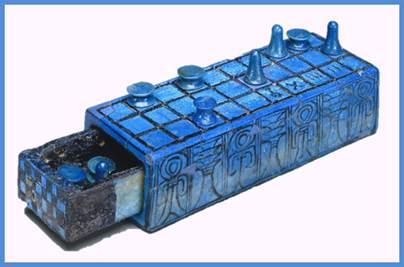
Senet Game Board with
Pieces: 1390 B.C.E.
Unit
Overview
In
this unit, you will discover that ancient Egypt produced more than amazing
pyramids, temples and tombs. Strange
gods, interesting views on the afterlife and mummies are just some of the
things from this culture that continue to fascinate us. Geometry, our calendar and current medical
practices all trace their roots back to ancient Egypt. Let’s see how it all happened.
Life
in Ancient Egypt
At
first, Egyptians lived in small villages along the banks of the Nile
River. As time passed, they produced food
surpluses. Therefore, everyone no longer
had to farm the land. Some people
specialized in making furniture, pottery or cloth. Others created works of art and
architecture. The economy and the
population grew. Egyptians established a
central government, cities and an organized religion. They also discovered more efficient ways of
doing things through advancements in technology. Because it was important to keep records,
Egyptians developed their own written language.
In other words, they built a civilization.
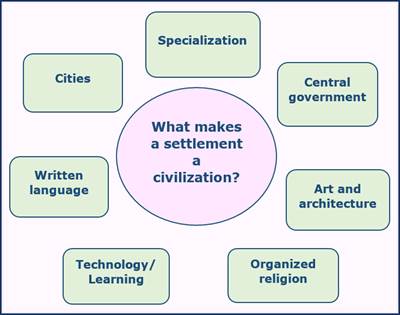
In
ancient Egypt, one pharaoh, or
leader, after another ruled for over 3,000 years. Although many dynasties rose to power and
disappeared during these times, the daily lives of the Egyptians changed very
little. Unlike Mesopotamia, Egypt did
not often experience attacks from outside forces. The weather was almost always the same. Eight months of the year were sunny and
hot. The other four months were sunny
and slightly cooler. Most of the region
received less than one inch of rainfall annually. Because of these factors, the average
Egyptian family continued many of the same practices for centuries.
Egyptian
Society
The
most powerful person in Egypt was the pharaoh.
He or she inherited the position and was considered a god. For this reason, people rarely questioned the
authority of the pharaoh. Because the
Egyptians believed that the Nile River and its annual floods were gifts from
the gods, priests were honored in their society. They were responsible for keeping the gods
happy by conducting religious ceremonies and by taking care of the
temples. They hired craftsmen and
skilled architects to build grand tombs for the pharaohs. After a while, the pharaohs needed help to
keep things running smoothly. To make
government more efficient, the empire was divided into forty-two
provinces. Officials within each
province reported to the pharaoh and managed many tasks, including the
collection of taxes.
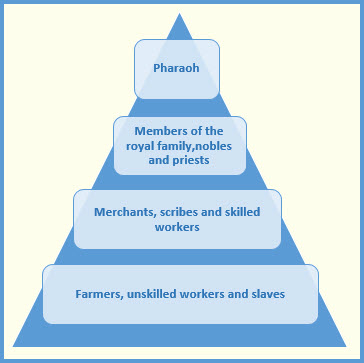
While
the pharaoh, members of the royal family, priests and government officials
filled the top levels of Egyptian society, farmers, laborers and slaves
remained at the bottom of the social pyramid. When farmers were not working in
their fields, they were often hired for construction projects. People who were unable to pay their debts,
committed crimes or were captured in battle often became slaves. Usually, Egyptian slaves were freed after
they had served for a period of time.
Unlike
other ancient civilizations, however, Egypt offered women greater
equality. They could legally own and
manage property. Although most women
remained at home and raised their children, some wove cloth or worked with
their husbands in the fields. Some women
held positions in government, and a few ruled as pharaohs. The first woman to be crowned a pharaoh was Hatshepsut. You can see her statue below. The video describes her reign and the massive
building projects that she directed.
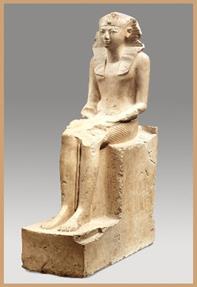
Children
in Egypt played with dolls, stuffed animals, and marbles. Along with competing in sports that used
balls and sticks, Egyptians enjoyed a board game called Senet. The picture at the
beginning of this unit shows the board and pieces used to play this game. Boys and girls from wealthier families
attended schools operated by scribes.
However, most children were taught at home and eventually did the same
jobs as their parents and grandparents.
Most Egyptians married in their middle teens. This seems very young by today’s standards,
but the life expectancy of the average Egyptian was thirty-six years.
The
Egyptian Gods and the Afterlife
The
Egyptians practiced polytheism, or
the belief in several gods. Some of the
most important ones are listed in the table below. As you can see, most of the gods and
goddesses were associated with forces of nature, such as water and sunshine, or
the afterlife.
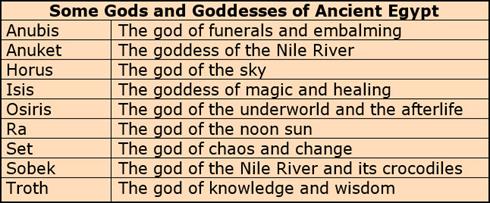
Paintings, carvings and statues preserved in ancient tombs and temples give us an idea of what the Egyptians thought their gods looked like. Sobek, for example, is pictured as having the head of a crocodile and the body of a man.
Egyptians
believed that their relationship with the gods carried over into the afterlife, or the continuation of life
after death. Some ancient cultures
thought that the afterlife would be sad, gloomy and miserable. This was not true of the Egyptians. They looked forward to a perfect existence and
ideal conditions, but not everyone was guaranteed this reward. Egyptians thought that bad behavior and evil
deeds made the heart heavy. Anubis, one of the gods, weighed the
heart of each person when they arrived in the underworld. Only those whose hearts were lighter than a
feather gained entrance to the afterlife.
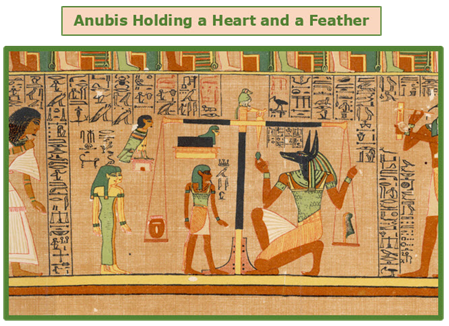
Egyptians
also thought that they would need their physical bodies in the afterlife. Therefore, it was important to preserve
them. To make this happen, they
developed the process of embalming. When a person died, an embalmer removed all
the internal organs with the exception of the heart. This required great skill because the surgeon
had to avoid damaging the rest of the body.
The remaining shell was filled with salt, herbs and spices. After the body dried, the embalmer wrapped it
hundreds of strips of linen cloth to create a mummy, which was much less likely to decay. The entire procedure took about ninety
days. It was so expensive that most
Egyptians simply could not afford it.
Most embalmed bodies were those of pharaohs and members of the royal
family. Learn more about the process of
mummification by watching the video listed below.
Mummified
bodies were placed in coffins inside tombs.
Tombs took various forms. Some
were pyramids like the ones in Giza; others were caves like the ones in the
Valley of the Kings. Artists often
decorated the inside of the tomb with paintings that reflected the person’s
life. Statues of guards and soldiers
that would come to life in the underworld were also sometimes included. Things that would be useful in the afterlife
or that the person enjoyed were added, too.
For example, one pharaoh’s tomb included a full-sized boat for sailing
on the rivers in the afterlife.
The
Development of Written Language
As
their civilization expanded, the Egyptians recognized the importance of keeping
records. To meet this need, they
developed a writing system based on hieroglyphs. Hieroglyphs are pictures that represent
sounds and words. At first, the
hieroglyphic system consisted of about 700 characters. Eventually, it included over 6,000
symbols. When Egypt declined, the
ability to read and write hieroglyphics was lost, and it was replaced by other
languages. For centuries, historians and
scholars were unable to decipher the meaning of ancient documents and
inscriptions on tombs.
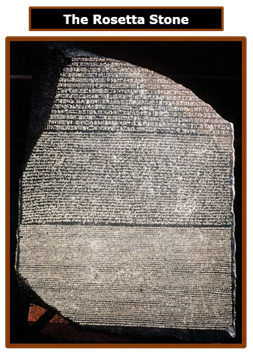
However, a major clue to solving the mystery of hieroglyphics was discovered by a group of French soldiers serving in Egypt in 1799. Named the Rosetta Stone, this polished rock was inscribed with the same message in three languages—hieroglyphics, a different version of hieroglyphics and Greek. Jean Francois Champollion, a language expert, cracked the code with similar skills that we use to work cryptogram puzzles today. Because of Champollion’s work, we now know and understand much more about the ancient Egyptians.
At
first, Egyptians recorded information on clay and stone, but they soon
developed a better writing surface. They
used papyrus reeds that grew along
the banks of the Nile River to create a paper-like material named after the
plants. Collecting the papyrus reeds was
a dangerous business as you will see when you watch the video listed
below. Workers cut the reeds into
strips, pressed them into thin sheets and dried them. The sheets were rolled into scrolls, which
were easily carried and stored.
Advancements
in Learning and Technology
Although
their pyramids and magnificent temples still amaze us, the Egyptians made other
contributions that continue to impact our modern world. Some of these achievements were related to
floods along the Nile River. Can you
imagine life without a 365-day calendar?
As Egyptian priests scanned the sky, they noticed that a particular
star, later called Sirius, appeared
shortly before the Nile River flooded.
The star returned to that same position every year after exactly 365
days. The Egyptians divided the number
of days between the appearances of Sirius into twelve months with thirty days
each. The remaining five days were used
for holidays and celebrations. The
calendar helped farmers to plant their crops at the right time and to harvest
them before the flood.
The
rising waters often washed away boundaries and property divisions. This meant that the land had to be surveyed,
re-measured and marked. To save time and
money, Egyptians came up with an efficient mathematical system to accomplish
this task. It later developed into what
we call geometry. At the same time, the government had to
decide how much tax Egyptians had to pay and how to collect it. This led to the development of a system of
written numbers for counting, adding, and subtracting. You can see some of the
hieroglyphic symbols used for numbers in the graphic below and in the video. This
knowledge spread throughout the Mediterranean world. Pythagoras, a Greek who is often called the
father of modern mathematics, was actually trained in Egypt.

In
many ways, Egyptian medical knowledge has become the foundation of modern
medicine. Although they sometimes relied
on spells and magic words, doctors, who were part of this ancient civilization,
examined patients, conducted tests and made diagnoses. They set broken bones, healed wounds and made
medicines from herbs. Because they
helped prepare bodies for mummification, many of Egypt’s doctors were also
skillful surgeons. This experience gave
them a good understanding of the body’s internal organs and their functions. As their medical reputations spread, people
came from all over the Mediterranean region to learn and to ask advice from
Egypt’s doctors.
How Do
We Know so Much about the Ancient Egyptians?
How
do we know so much about life in ancient Egypt?
After all, the people that we have been reading about existed a very
long time ago. We have learned a great
deal from documents and inscriptions that were written in hieroglyphics. Artifacts have also revealed many things
about this African civilization.
However, recovering these objects was not as easy as you might think. Yes, the pharaohs and members of their
families were often buried with items to help them enjoy the afterlife. Some of these things were made from or
trimmed in gold. Embalmers sometimes
added jewels and gem stones to the linen wrappings surrounding a mummy. Unfortunately, every society has its share of
criminals, and ancient Egypt was no exception.
Pyramids and tombs were often raided and robbed of their treasures.
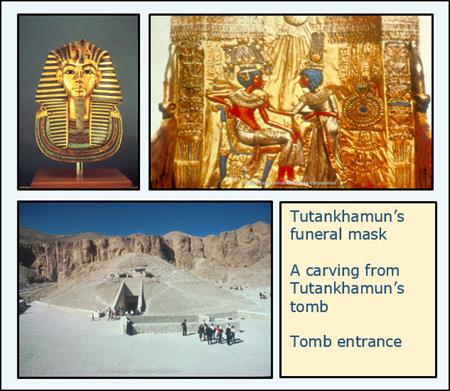
Nonetheless,
over the centuries, Egyptologists,
or archaeologists that concentrate on the study of ancient Egypt, have found
tombs to be a valuable source of information.
The Tomb of Tutankhamen, located
in the Valley of the Kings, is a
rare example of a burial place that was found intact. This relatively small tomb was built for
Tutankhamen, a young boy crowned pharaoh at the age of eight. He died at seventeen. Howard
Carter, a British archeologist, and Lord
Carnarvon, his financial backer,
excavated the tomb with a crew of workmen in 1922. It included the ruler’s mummified body and
over 3,000 artifacts that are still being examined and categorized. It is considered one of the world’s top
historical discoveries. The search for
clues that tell us about life in ancient Egypt continues today. In 2018, archaeologists uncovered the tomb of
Hetpet, an Egyptian priestess. Although her mummy is missing, the articles
found on the burial site are over 4,000 years old.
As
we wrap up our work on ancient Egypt, think about Mesopotamia, another ancient
civilization that you recently studied.
How were these two civilizations alike?
How were they different? Click on
the icon below. The worksheet will test
your knowledge of the similarities and differences between life along the Nile
and life in the Fertile Crescent.
Time
for a Quick Review
Before
moving on to Unit 14, review the names and terms found in Unit 13. Be sure you can answer the “Can I” questions
with a loud “yes”.
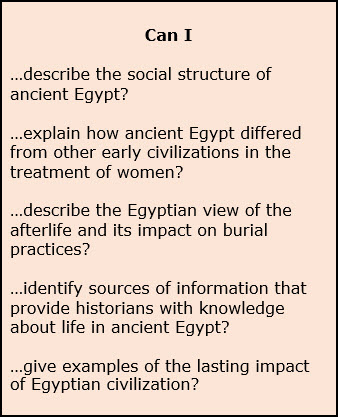

Additional Activities and Resources
Ancient
Egyptian Social Structure (article
with quiz)
